Bren light machine gun
| Bren Light Machine Gun | |
|---|---|
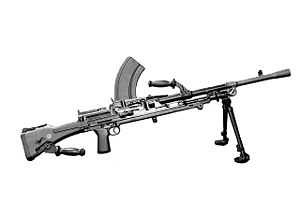 Early Mark I Bren LMG, photo from a Canadian factory | |
| Type | Light machine gun |
| Place of origin |
|
| Service history | |
| In service | 1938–2006 |
| Used by | See Users |
| Wars |
World War II Chinese Civil War Malayan Emergency Korean War Suez Crisis Sino-Indian War Congo Crisis Rhodesian Bush War The Troubles Falklands War other conflicts |
| Production history | |
| Designed | 1935 |
| Manufacturer |
Royal Small Arms Factory Enfield John Inglis and Company Long Branch Factory Ishapore Lithgow Small Arms Factory. |
| Produced | 1935–1971 |
| Variants |
Mk I, II, III, IV L4 |
| Specifications | |
| Weight | 22.83 lb (10.35 kg) (Mk1 and Mk2) (25lb–11.25 kg loaded); 8.68 kg (Mk3 and Mk4) (21.6lb–9.75 kg loaded) |
| Length | 42.9 in (1,156 mm), Mk IV |
| Barrel length | 25 in (635 mm) |
| Crew | 2, firer and magazine/barrel changer |
|
| |
| Cartridge |
.303 British 8×57mm IS (for China in World War II) 7.62×51mm NATO (post-WW2) |
| Action | Gas-operated, tilting bolt |
| Rate of fire | 500–520 rounds/min |
| Muzzle velocity | 2440 ft/s (743.7 m/s) |
| Effective firing range | 600 yd (550 m) |
| Maximum firing range | 1850 yd |
| Feed system |
20 round L1A1 SLR magazine 30-round detachable box magazine 100-round detachable pan magazine |
| Sights | Iron |
The Bren Gun, usually called simply the Bren, was a series of light machine guns adopted by Britain in the 1930s and used in various roles until 1991. While best known for its role as the British and Commonwealth forces' primary infantry light machine gun (LMG) in World War II, it was also used in the Korean War and saw service throughout the latter half of the 20th century, including the 1982 Falklands War and the 1991 Gulf War. Although fitted with a bipod, it could also be mounted on a tripod or vehicle-mounted.
The Bren was a modified version of Czechoslovak-designed light machine guns, the ZB vz. 26 and its descendants, which British Army officials had tested during a firearms service competition in the 1930s. The later Bren featured a distinctive top-mounted curved box magazine, conical flash hider and quick change barrel. The name Bren was derived from Brno, Moravia, the Czechoslovak city where the Zb vz. 26 was originally designed (in Zbrojovka Brno Factory), and Enfield, site of the British Royal Small Arms Factory. The father of the Bren - the original and main designer was Václav Holek, a talented gun inventor and design engineer.
In the 1950s many Brens were rebarrelled to accept the 7.62×51mm NATO cartridge and modified to feed from the magazine for the L1 (Commonwealth version of the FN FAL) rifle as the L4 light machine gun. It was replaced in the British Army as the section LMG by the L7 general-purpose machine gun (GPMG), a heavier belt-fed weapon. This was in turn supplemented in the 1980s by the L86 Light Support Weapon firing the 5.56×45mm NATO round, leaving the Bren in use only as a pintle mount on some vehicles.
The Bren is still sold by Indian Ordnance Factories as the "Gun, Machine 7.62mm 1B".[1]
Development
During the early 1900s, the British Army subjected several designs of light machine gun to competitive trials. Among the weapons that were submitted for the trials were the Madsen, Browning Automatic Rifle (BAR), the Neuhausen KE7 and the Vickers-Berthier. The Vickers-Berthier was later adopted by the Indian Army and also saw extensive service in World War II.
Following these trials, the British Army adopted the Czechoslovak ZB vz.26 light machine gun manufactured in Brno in 1935, although a slightly modified model, the ZB vz. 27, rather than the ZB vz. 26 had actually been submitted for the trials. A licence to manufacture was sought, and the Czech design was modified to British requirements. The major changes were in the magazine and barrel. The magazine was curved in order to feed the rimmed .303 British cartridge, a change from the various rimless Mauser-design cartridges such as the 7.92 mm Mauser round previously used by Czech designs. These modifications were categorised in various numbered designations, ZB vz. 27, ZB vz. 30, ZB vz. 32, and finally the ZB vz. 33, which became the Bren.
The Bren was a gas-operated weapon, which used the same .303 ammunition as the standard British rifle, the Lee-Enfield, firing at a rate of between 480 and 540 rounds per minute (rpm), depending on the model. Propellant gases vented from a port towards the muzzle end of the barrel through a regulator (visible in the photo, just in front of the bipod) with four quick-adjustment apertures of different sizes, intended to tailor the gas volume to different ambient temperatures (smallest flow at high temperature, e.g. summer desert, largest at low temperature, e.g. winter Arctic). The vented gas drove a piston which in turn actuated the breech block. Each gun came with a spare barrel that could be quickly changed when the barrel became hot during sustained fire, though later guns featured a chrome-lined barrel which reduced the need for a spare. To change barrels, the release catch in front of the magazine was rotated to unlock the barrel. The carrying handle above the barrel was used to grip and remove the hot barrel without risk of burning the hands.
The Bren was magazine-fed, which slowed its rate of fire and required more frequent reloading than British belt-fed machine guns such as the larger .303 Vickers machine gun. However, the slower rate of fire prevented more rapid overheating of the Bren's air-cooled barrel, and the Bren was much lighter than belt-fed machine guns which typically had cooling jackets, often liquid filled. The magazines also prevented the ammunition from getting dirty, which was more of a problem with the Vickers with its 250-round canvas belts.
Service
Second World War

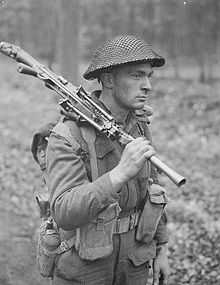
In the British and Commonwealth armies, the Bren was generally issued on a scale of one per rifle section, with three rifle sections in each platoon.[2] A further three Bren guns were issued to the Admin platoon of each rifle company.[citation needed] An infantry battalion also had a "carrier" platoon, equipped with Universal Carriers, most of which carried Bren guns. Parachute battalions from 1944 had an extra Bren in the AT platoon.[3] The 66-man "Assault Troop" of British Commandos had a nominal establishment of four Bren guns. Realising the need for additional section-level firepower, the British Army endeavoured to issue the Bren in great numbers, with a stated goal of one Bren to every four private soldiers.[4]
The Bren was operated by a two-man crew, sometimes commanded by a Lance Corporal as an infantry section's "gun group", the remainder of the section forming the "rifle group". The gunner or "Number 1" carried and fired the Bren, and a loader or "Number 2" carried extra magazines, a spare barrel and a tool kit. Number 2 helped reload the gun and replace the barrel when it overheated, and spotted targets for Number 1.
Generally, the Bren was fired from the prone position using the attached bipod.[5] On occasion, a Bren gunner would use his weapon on the move supported by a sling, much like an automatic rifle, and from standing or kneeling positions. Using the sling, Australian soldiers regularly fired the Bren from the hip, for instance in the marching fire tactic, a form of suppressive fire moving forward in assault. A Victoria Cross was awarded to Private Bruce Kingsbury for such use at Isurava, New Guinea in 1942, during the Australians' fighting retreat from Kokoda.
Each British soldier's equipment normally included two magazines for his section's Bren gun. The large ammunition pouches on the 1937 Pattern Web Equipment were designed around the Bren magazine. Every soldier would be trained to fire the Bren in case of an emergency, though these soldiers did not receive a Bren proficiency badge.[citation needed]
The Bren had an effective range of around 600 yards (550 m) when fired from a prone position with a bipod. Initial versions of the weapon were sometimes considered too accurate because the cone or pattern of fire was extremely concentrated. Soldiers often expressed a preference for worn-out barrels in order to spread the cone of fire and increase suppressive effects. Later versions of the Bren addressed this issue by providing a wider cone of fire.[4]
For a light machine gun of the interwar and early World War II era, the Bren was about average in weight. On long marches in non-operational areas it was often partially disassembled and its parts were carried by two soldiers. The top-mounted magazine vibrated and moved during fire, making the weapon more visible in combat, and many Bren gunners used paint or improvised canvas covers to disguise the prominent magazine.[6]
The 30-round magazine was in practice usually filled with 27 or 28 rounds to prevent jams and avoid wearing out the magazine spring. Care needed to be taken when loading the magazine to ensure that each round went ahead of the previous round, so that the .303 cartridge rims did not overlap the wrong way, which would cause a jam.
In general, the Bren was considered a reliable and effective light machine gun, though in North Africa it was reported to jam regularly unless kept very clean and free of sand or dirt.[4] It was popular with British troops, who respected the Bren for its reliability and combat effectiveness. The quality of the materials used would generally ensure minimal jamming. When the gun did jam through fouling caused by prolonged firing, the operator could adjust the four-position gas regulator to feed more gas to the piston increasing the power to operate the mechanism. The barrel needed to be unlocked and slid forward slightly to allow the regulator to be turned. It was even said that all problems with the Bren could simply be cleared by hitting the gun, turning the regulator, or doing both.

A complicated tripod mount was available to allow the Bren to be used as an indirect-fire weapon, but this was rarely used in the field. The Bren was also used on many vehicles, including on Universal Carriers, to which it gave the alternative name "Bren Gun Carrier", and on tanks and armoured cars. However, it could not be used as a co-axial weapon on tanks, as the magazine restricted its depression and was awkward to handle in confined spaces, and it was therefore used on a pintle mount only. (The belt fed Vickers or BESA, the latter being another Czechoslovak machine gun design adopted by the British, were instead used as co-axial weapons.)
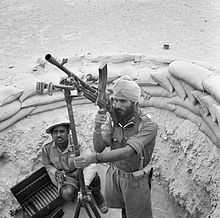
The Bren was also employed in the anti-aircraft role. A tall tripod was available to allow high angle fire. There were also several designs of less portable mountings, including the Gallows and Motley mounts. A 100-round pan magazine was available for the Bren for use in the anti-aircraft role.[7]
The Bren's direct ancestor, the Czechoslovak ZB vz. 26, was also used in World War 2 by German and Romanian forces, including units of the Waffen SS. Many 7.92 mm ZB light machine guns were shipped to China, where they were employed first against the Japanese in World War II, and later against UN forces in Korea, including British and Commonwealth units. Some ex-Chinese Czech ZB weapons were also in use in the early stages of the Vietnam War.
Production of a 7.92 mm round model for the Far East was carried out by Inglis of Canada.
Post-war
The Bren was used by the British Army, and the armies of various countries of the Commonwealth, in the Korean War, the Malayan Emergency, the Mau Mau Uprising and the Indonesia–Malaysia confrontation, where it was preferred to its replacement, the belt-fed GPMG, on account of its lighter weight. During the Falklands War in 1982, 40 Commando Royal Marines carried one LMG and one GPMG per section.
When the British Army adopted the 7.62 mm NATO cartridge, the Bren was re-designed to 7.62 mm calibre, fitted with a new bolt, barrel and magazine. It was redesignated as the L4 Light Machine Gun (in various sub-versions) and remained in British Army service into the 1990s. The conical flash hider was replaced by the slotted type similar to that of the contemporary L1 rifle and L7 General Purpose Machine Gun. The change from a rimmed to rimless cartridge and nearly straight magazine improved feeding considerably, and allowed use of 20-round magazines from the 7.62 mm L1A1 Self-Loading Rifle. The 30-round magazine from the L4 also fitted the L1A1 rifle, but the magazine spring was not always strong enough to provide enough upward pressure to feed rounds correctly, this being remedied by stretching the magazine springs.
Completion of the move to a 5.56 mm NATO cartridge led to the Bren/L4 being removed from the list of approved weapons and then withdrawn from service. The fact that Bren guns remained in service for so many years with so many different countries in so many wars says much about the quality of the basic design.
The Mark III Bren remained in limited use with the Army Reserve of the Irish Defence Forces until 2006, when it was replaced by the 7.62 mm FN MAG (GPMG). The weapon was popular with the soldiers who fired it (known as Brenners) as it was light and durable, and had a reputation for accuracy. The most notable use of the Bren by Irish forces was in the Congo Crisis during the 1960s, when the Bren was the regular army's standard section automatic weapon.
Variants
Mark 1
From September 1937. The original Bren based on the Czechoslovak gun.
Features:
- Drum pattern rear aperture sight
- Buttstrap for use over the shoulder when firing
- Rear grip under butt
- Telescoping bipod
- Folding cocking handle
Mark 2
Introduced 1941. A simpler version of the Mk 1. Produced by Inglis of Canada and the Monotype Group through a number of component manufacturing factories. Sometimes known as the "Garage hands" model.
Features:
- Folding leaf rear sight
- Buttstrap deleted
- Rear grip deleted
- Fixed height bipod
- Fixed cocking handle
The Bren Mk2 was much simplified in the body, which although still being milled from a solid billet of steel, required significantly fewer milling operations than the Mk1 which gave it a much cleaner appearance. The bipod was simplified in design as well as not having extending legs. Most Mk2 bipods resembled a simple 'A' frame and were more 'soldier proof'. The Mk2 also featured a slightly higher rate of fire than the Mk1. The woodwork on the Mk2 was simplified by being less ornate and ergonomic, which sped up the manufacturing process. The barrel was also simplified by means of a non-stepped removable flash hider and in some cases, a barrel fore-end that was matte instead of highly polished. The buffered buttplate of the Mk1 was omitted and replaced with a sheet metal buttplate.
Mark 3
A shorter and lighter Bren made by Enfield from 1944 for the war in the East and for Airborne Forces. This was a conversion of the Mk1 whose main distinguishing feature was a shorter barrel.
Mark 4
As with the Mk3 but this was a conversion of a Mk2.
L4

A conversion of the Bren to 7.62mm NATO from 1958. Indian Army variants may be new-build, not conversions. L4 Brens can easily be identified by their different magazine. The British-issue L4 magazine is of 30-round capacity and has a slight curve. The L4 magazine was interchangeable with the L1A1 SLR magazine, so the L4 Bren also can be seen fitted with straight 20-round magazines from the SLR or with the straight 30-round magazine from the Australian L2A1 or Canadian C2A1 heavy-barrel SLR. The flash suppressor was changed from the cone type of .303 variants to a slotted type similar in appearance to that used on the SLR and L7 GPMG. All L4s are chambered for 7.62×51mm NATO rimless ammunition.
| Designation | Description |
|---|---|
| L4A1 | Bren Mk III conversion, with Mk I bipod and steel barrel |
| L4A2 | Bren Mk III conversion, lightened bipod and steel barrel |
| L4A3 | Bren Mk II conversion |
| L4A4 | L4A2 variant with chrome-plated steel barrel |
| L4A5 | L4A3 with chrome-plated steel barrel for Royal Navy |
| L4A6 | L4A1 variant with chrome barrel |
| L4A9 | Bren conversion with L7 dovetail |
Taden gun
The Taden gun was a development of the Bren to use with the .280 British intermediate round proposed to replace the .303 in British service. The Taden was belt-fed with spade grips and would have replaced both the Bren and the Vickers machine gun. Although reliable[citation needed] it was not accepted due to the US-driven standardization within NATO on the larger 7.62x51mm NATO round.[8]
Semiautomatic Bren guns
Many nations' militaries have disposed of their Bren guns as surplus to their needs. Surplus Brens have been imported to the United States for sale to collectors, but due to US gun laws restricting the importation of automatic weapons such guns must be legally destroyed by cutting up the receivers. A number of US gunsmiths have manufactured new semiautomatic Brens by welding the pieces of destroyed receivers back together, with modifications to prevent the use of full automatic parts, and fitting new fire control components capable of only semiautomatic fire. The balance of the parts are surplus Bren parts. Such "semiautomatic machineguns" are legally considered rifles under US Federal law and the laws of most states.
Twin barrel variant
A twin barrel variant of the Bren was manufactured in China during the 1950s from ZB26 light machine guns.[9] It came with side by side barrels and was chambered in the 7.62x39mm round fed from AK-47 magazines. The only known example can be seen at the Tongzhou militia museum.[10][11][12]
World War II production
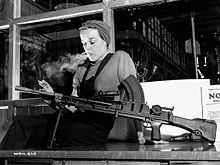
- RSAF Enfield, UK: 400 per month.
- 1943: 1,000 per week.
- John Inglis and Company, Canada: A contract was signed with the British and Canadian governments in March 1938 to supply 5,000 Bren machine guns to Great Britain and 7,000 Bren machine guns to Canada. Both countries shared the capital costs of bringing in this new production facility. Production started in 1940, and by 1943 Inglis was producing 60% of the world output of Bren machine guns.
- Long Branch, Toronto, Canada.
- Ishapore, India.
- Lithgow Small Arms Factory, Australia.
Users

- Australia: during World War II and Korean War.
- Bangladesh[13]
- Barbados[13]
- Belize[13]
- Botswana[13]
- Bulgaria: during World War II.
- Canada: during World War II and Korean War.
- People's Republic of China: During the Chinese Civil War
- Republic of China: Chinese National Revolutionary Army of Generalissimo Chiang Kai-shek of the Republic of China during the Second Sino-Japanese War and the Chinese Civil War
- Democratic Republic of Congo[13]
- Gambia[13]
- Ghana[13]
- Greece
- Guyana[13]
- India: manufactured by the Ordnance Factories Board[13][14]
- Ireland: Irish Defence Forces replaced by the FN MAG in 1960s, used by the Reserve Defence Forces (RDF), until 2006.
- Israel: during its war of independence and for some time thereafter.
- Italy: airdropped to partisans and also issued to the Italian Co-Belligerent Army in the latter part of WWII. Also used by the Italian Police in the 7.62 mm calibre.
- Jamaica: still used by the Jamaica Combined Cadet Force
- Kenya[13]
- Lesotho[13]
- Luxembourg
- Malaysia: General Operations Force of the Royal Malaysian Police (before replaced by the German-made 7.62 NATO HK 11).
- Mauritius[13]
- Nepal[13]
- Netherlands: The Netherlands Royal Army during World War II and thereafter until 1964, the Netherlands Royal Army Reserve Corps from 1948 until 1989 and the Royal Netherlands Air Force from 1945 until 1964.
- New Zealand : WW2 and L4 post war
- Poland: Poland during World War II.
- Rhodesia
- Seychelles[13]
- South Africa
- Sri Lanka: Sri Lanka Army
- Suriname[13]
- Swaziland[13]
- Thailand
- Tonga[13]
- Trinidad and Tobago[13]
- Uganda[13]
- United Kingdom: British and Commonwealth forces, and cadet forces until the introduction of the L98 Cadet Rifle
- Yugoslavia: Yugoslav Chetniks during World War II; some remained in stockpiles until Balkan wars of '90s
- Zimbabwe[13]
Gallery of images
-

At the Battle of Ortona, December 1943
-

Welsh Guards in action with a Bren near Cagny, July 1944
-
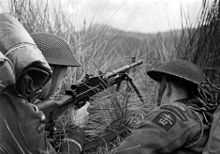
Bren without the magazine fitted used by Polish Commandos
-

Members of the Milice with Bren guns.
-

Bren near Tilburg, October 1944
-

Bren in Canadian museum
-

Twin Bren anti-aircraft mounting
-

Bren Mk3
-

Universal Carrier
-

A Bren in an anti-aircraft mount
See also
- Taden gun
- Charlton Automatic Rifle
- Besal
- Sterling 7.62
- Kucher Model K1
- FM 24/29 light machine gun
- Type 96 Light Machine Gun
- Type 99 Light Machine Gun
- DP-28
- M1918 Browning Automatic Rifle
- Huot Automatic Rifle
- Veronica Foster, aka The Bren Gun Girl
- Type 99 Light Machine Gun
- ZB-530
- Universal Carrier (Bren Gun Carrier)
- Vickers-Berthier
- Vickers K machine gun
Notes
- ↑ Ordnance Factory Board
- ↑ British Infantry Battalion, June 1944, Rifle Company.
- ↑ The British Parachute Battalion, circa 1944 to 1945.
- ↑ 4.0 4.1 4.2 Dunlap
- ↑ "It [the L4A4 Bren] is normally fired from the shoulder in the lying position, supported by the bipod, although it may be fired from other positions to engage targets at close range". Chapter 1, Section 1, para 102, Australian Army Manual of Land Warfare, Part 2, Infantry Training, Vol 4 Pam 6, Machine Gun 7.62mm L4A4, Australian Government 1979.
- ↑ George, John
- ↑
- ↑ Assault rifles and their ammunition.
- ↑ http://b11.cnc.qzone.qq.com/cgi-bin/blognew/blog_output_data?uin=2396467630&blogid=1345345996&styledm=cnc.qzonestyle.gtimg.cn&imgdm=cnc.qzs.qq.com&bdm=b.cnc.qzone.qq.com&mode=2&numperpage=15&blogseed=0.3048486567568034&prop
- ↑ http://www.militarybbs.cn/thread-19788-1-1.html
- ↑ http://www.militarybbs.cn/data/attachment/forum/201305/25/202049ak7acqgffqzs4ssc.jpg
- ↑ http://bbs.tiexue.net/post_6531365_1.html
- ↑ 13.0 13.1 13.2 13.3 13.4 13.5 13.6 13.7 13.8 13.9 13.10 13.11 13.12 13.13 13.14 13.15 13.16 13.17 13.18 13.19 Jones, Richard D.; Ness, Leland S., eds. (January 27, 2009). Jane's Infantry Weapons 2009/2010 (35th ed.). Coulsdon: Jane's Information Group. ISBN 978-0-7106-2869-5.
- ↑ http://ofbindia.gov.in/products/data/weapons/wsc/16.htm
References
- Dunlap, Roy F. (1948). Ordnance Went Up Front. The Samworth Press.
- George, John (Lt. Col.) (1948). Shots Fired In Anger. The Samworth Press.
External links
| Wikimedia Commons has media related to Bren. |
- The Light Machine Gun
- Photogallery of BREN Mk. I
- Photo of L4 Bren gun in use with Nepalese army, circa 2006
- Twin barrel Bren LMG
- Modern Firearms (additional information)
| |||||||||||||||||
| |||||||||||||||||||||||||||||||||||
| ||||||||||||||||||||